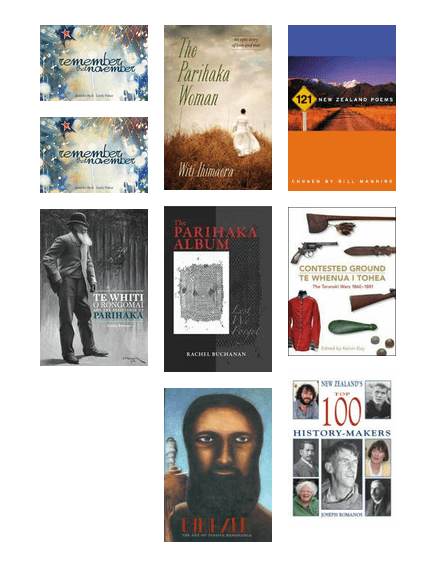Parihaka
This page details some of the key resources at your library about the peaceful resistance to the militia invasion of the Taranaki settlement of Parihaka on 5 November 1881 – and the Christchurch connection to this significant historical event.
Parihaka
Maatakiwi talks about the importance of the 5th of November, the day the Māori settlement of Parihaka was invaded. [13MB, 10 minutes 40 seconds]
The Taranaki settlement of Parihaka
Parihaka had grown in the wake of the land wars of the 1860s, and by the 1870s was the largest Māori village in the country. This self-sufficient community was made up of Māori who had become dispossessed during the land conflicts and was led by two prophets – Te Whiti o Rongomai and Tohu Kākahi.
Militia action and passive resistance
On 5 November 1881 the Parihaka community in Taranaki was invaded by 1500 militia and armed constabulary. The invading forces were greeted by singing children and 2000 peaceful residents who did not resist either invasion or arrest. Over the course of two weeks, the army demolished much of the settlement and eventually all crops and livestock were destroyed.
It is estimated that around 1600 people were either evicted or taken prisoner.
Civil disobedience and imprisonment without trial
Residents faced further Government confiscations of land around the Parihaka settlement. They tried to prevent this confiscation by using tactics of passive resistance – ploughing and building fences across lands and roads, and removing pegs that had been placed by Government surveyors.
Often those who were caught engaging in these activities were arrested and imprisoned without trial in South Island prisons in Dunedin, Lyttelton (Ripapa Island) and Hokitika.
Here they were used as labourers on projects like road-building. In Dunedin, the harsh conditions under which they were jailed meant that some of these prisoners died, mainly from tuberculosis.
The last prisoners were released in 1898.
The Christchurch connection
The leaders Tohu and Te Whiti were exiled for two years and interned in Christchurch at Addington gaol. During that time, they were shown the Kaiapoi Woollen Mills, Christchurch Railway workshops, ChristChurch Cathedral and Canterbury Museum in an attempt by officials to demonstrate the advanced technology and power of the pakeha
.
Both prisoners were treated as oddities and objects of curiosity by Cantabrians. In numerous newspaper reports of the day local people are described as gathering in crowds to stare at them at every occasion - from their first appearance off the ship at Lyttelton, to a visit to the 1882 New Zealand International Exhibition, to their arrival off the train at Ashburton.
Christchurch man Harry Ell, who was most notable for his involvement in creating the Summit Road, was part of the armed constabulary that invaded Parihaka in 1881. He was later critical of the race policies of those years saying, [their] ‘actions had … brought about the bitterness and estrangement between the two races….’
The legacy of Parihaka
The invasion of Parihaka eventually came to be seen as a black day in New Zealand history, and a symbol of injustice. It has been an inspiration for works by New Zealand artists, writers and musicians, like Witi Ihimaera's historical novel, The Parihaka woman, and Tim Finn’s song Parihaka. Several international peace festivals have been held at Parihaka.
He Puanga Haeata / Parihaka reconciliation
The Crown and the Parihaka community signed a Deed of Reconciliation on 9 June 2017 at a ceremony held at Parihaka.
- Read the Deed of reconciliation.
- Deed of Reconciliation signed with Parihaka Christopher Finlayson.
More about Parihaka
- Staff list of books and online resources: Parihaka
- Search our catalogue for Parihaka
- The New Zealand wars : a history of the Maori campaigns and the pioneering period by James Cowan. The chapter on the Invasion of Parihaka is also available online.
- Te Whiti o Rongomai of Parihaka as seen by his contemporaries
- Wanderings with the Maori prophets, Te Whiti and Tohu (with illustrations of each chief) : being reminiscences of a twelve months’ companionship with them, from their arrival in Christchurch in April, 1882, until their return to Parihaka in March, 1883
- The Taranaki Report: Kaupapa Tuatahi Waitangi Tribunal. [PDF]
Resources and reading about Parihaka
Online resources
Parihaka: A DigitalNZ story by National Library of New Zealand
View a set of images of Parihaka on Digital NZ
Parihaka
Search DigitalNZ for images and articles on Parihaka.
New stories about Parihaka Radio New Zealand
Parihaka Attack NZ History
Parihaka in the AtoJs
Search the Appendices to the Journals of the House of Representatives (AtoJs or AJHRs) for references to Parihaka.
Parihaka Memorial
On the north-west corner of the old Dominion Museum building is a memorial to the prisoners from Parihaka, in Taranaki, who were held at Mount Cook Barracks in 1879.” Information from the Manatū Taonga Ministry for Culture and Heritage.
Taranaki tribe - Resistance
Article by Te Miringa Hōhaia on passive resistance and Parihaka from Te Ara - The encyclopedia of New Zealand.
Tariana Turia - Petition to Parliament for 5 November to become Parihaka Day
Text of a speech by Hon Tariana Turia, MP for Te Tai Hauauru to the Government Administration Select Committee, 11 May 201
Tatarakihi: The Children of Parihaka
Tatarakihi is a film that tells the story of a 'journey of memory' taken by a group of Parihaka children who travel to the South Island 130 years later.
Te Whiti-o-Rongomai
Biography from nzhistory.
The Raid upon Parihaka
Chapter XX in History of New Zealand, Vol. III. by George William Rusden.
The Taranaki frontier and the expedition to Parihaka
The New Zealand Wars: A History of the Maori Campaigns and the Pioneering Period: Volume II: The Hauhau Wars, 1864-72 by James Cowan.

![Parihaka by Josiah Martin, [ca 1880]](https://cclblog.files.wordpress.com/2015/11/1997_34_7.jpg)






